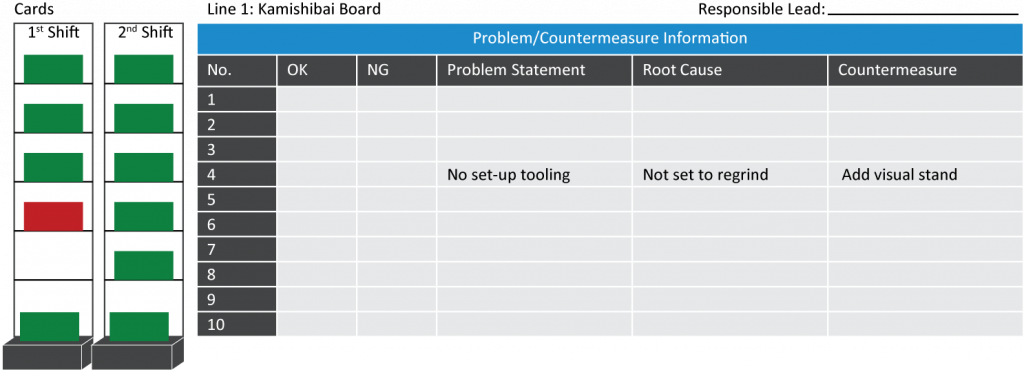
The degree to which a leader can quickly grasp the reality of a situation during a leader standard work (LSW) audit – or during the more open-ended gemba walk – largely depends on the type and quality of visual controls in use. The ancient Japanese art form of kamishibai has entrenched itself as one of the foremost management tools for performing audits in manufacturing environments.
Literally meaning ‘paper drama’, Kamishibai is a form of storytelling that originated in Japanese Buddhist temples in the 12th century. Monks used picture scrolls to convey stories with moral lessons to their audience, many of whom were illiterate.
As a component of the Toyota Production System (TPS), kamishibai boards are practical visual control tools that assist with the allocation, sequencing, execution and follow-up of key work routines and tasks. They are visual management tools much like hour-by-hour production status boards. If hour-by-hour boards are used during the shift and on an hourly or bi-hourly cadence, kamishibai boards are used for weekly, monthly and even quarterly audits.
Also referred to as ‘T-card systems’, kamishibai boards in their simplest form consist of a board that displays selected tasks according to a certain logic (area, task, category, etc.) in relation to a time period (hour/day, week, etc.). Each task is displayed on a separate double-sided card (red and green) with a wider portion at the top for the title, hence the term ‘T-card’.
The board allows for easy visual control as the following things will be obvious to the attentive leader or anyone observing the shop floor and the board for that matter:
- Whether the board is being used or not
- Whether the tasks are being carried out in the intended sequence
- Whether any problems were encountered and logged
The following example is of a basic visual control board that is used to allocate tasks (process-level checks in this case) to a first-line supervisor as part of his daily LSW routines.

Basically, there are two primary ways of using kamishibai boards:
Application 1:
Although this one is for task allocation (5S tasks at process level or key team leader routines during the day for the LSW level), it also leads to a process of ‘natural auditing’ as any deviations are immediately obvious, even to a casual observer. This is a very powerful application, but it can lead to frustration and a lack of discipline if implemented on too broad a scale and without careful planning.
When an organization is on a journey of creating, standardizing and improving practices on a wide front, a great many tasks are being generated. If all these tasks are visualized and controlled by means of the kamishibai system, it will lead to a deluge of tasks and multiple boards that are often not respected or kept up to date.
It is best to reserve the kamishibai approach for critical tasks that have been developed and executed well using a more conventional check sheet or board. This doesn’t mean that tasks won’t change once it has been transferred to the T-card system. They will always be adjusted and improved upon. The point is that kamishibai is best applied as a visual enhancement when a mature level of practice has been reached.
Application 2:
The preferred starting point for the T-card system is to allocate and visualize process-level audits carried out by team leaders and the one or two levels above. It then becomes a dynamic system where a few of the process-level tasks (among a great number that are being executed daily) are checked in the given time period (daily or weekly, as appropriate).
These tasks are randomly selected by the leader doing the audits (supervisor auditing the team leader or senior manager auditing the manager, etc.) from a box containing a large number of process-level activities next to the T-card board. This keeps the audits fresh and ensures that a wide variety of tasks or activities can be studied by the leaders over a reasonable period of time, without having to cover absolutely all tasks.
Although kamishibai is incredibly simple to use, remember that LSW audits are a mature practice and shouldn’t be rushed into. The fact is that even with excellent visual management and visual controls in place, it takes experience and coaching to gain a deeper understanding of what one is going to see. It requires a coaching style that relies on thoughtful questioning and presupposes that excellent listening skills exist.
There are also other important aspects to LSW that need to be explored and understood first. The How To Guide: Leader Standard Work for Executive Leadership offers some useful guidelines on how leader standard work can help shape a proactive management style that will not only empower your people, but will help you maintain visibility of the overall health of your organization.
